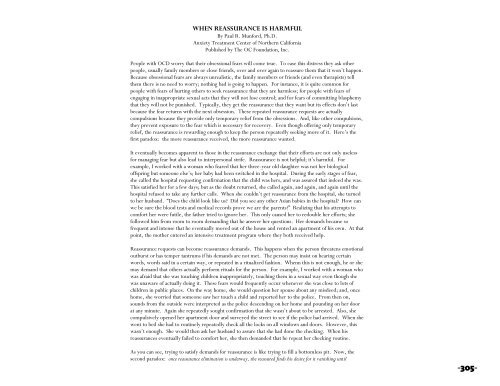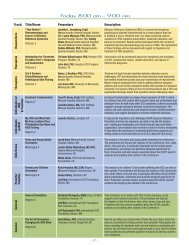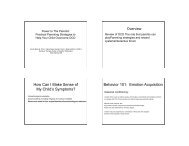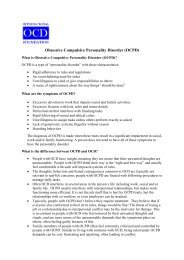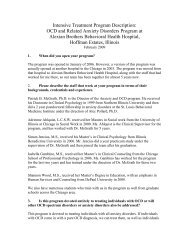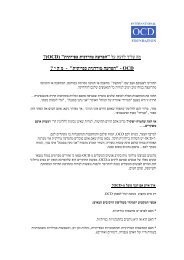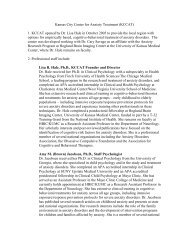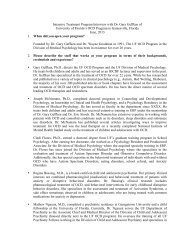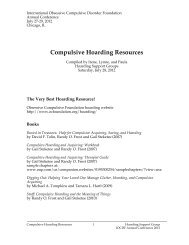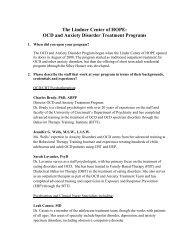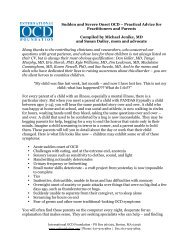perfectionism and - Obsessive-Compulsive Foundation
perfectionism and - Obsessive-Compulsive Foundation
perfectionism and - Obsessive-Compulsive Foundation
Create successful ePaper yourself
Turn your PDF publications into a flip-book with our unique Google optimized e-Paper software.
WHEN REASSURANCE IS HARMFUL<br />
By Paul R. Munford, Ph.D.<br />
Anxiety Treatment Center of Northern California<br />
Published by The OC <strong>Foundation</strong>, Inc.<br />
People with OCD worry that their obsessional fears will come true. To ease this distress they ask other<br />
people, usually family members or close friends, over <strong>and</strong> over again to reassure them that it won’t happen.<br />
Because obsessional fears are always unrealistic, the family members or friends (<strong>and</strong> even therapists) tell<br />
them there is no need to worry; nothing bad is going to happen. For instance, it is quite common for<br />
people with fears of hurting others to seek reassurance that they are harmless; for people with fears of<br />
engaging in inappropriate sexual acts that they will not lose control; <strong>and</strong> for fears of committing blasphemy<br />
that they will not be punished. Typically, they get the reassurance that they want but its effects don’t last<br />
because the fear returns with the next obsession. These repeated reassurance requests are actually<br />
compulsions because they provide only temporary relief from the obsessions. And, like other compulsions,<br />
they prevent exposure to the fear which is necessary for recovery. Even though offering only temporary<br />
relief, the reassurance is rewarding enough to keep the person repeatedly seeking more of it. Here’s the<br />
first paradox: the more reassurance received, the more reassurance wanted.<br />
It eventually becomes apparent to those in the reassurance exchange that their efforts are not only useless<br />
for managing fear but also lead to interpersonal strife. Reassurance is not helpful; it’s harmful. For<br />
example, I worked with a woman who feared that her three-year old daughter was not her biological<br />
offspring but someone else’s; her baby had been switched in the hospital. During the early stages of fear,<br />
she called the hospital requesting confirmation that the child was hers, <strong>and</strong> was assured that indeed she was.<br />
This satisfied her for a few days; but as the doubt returned, she called again, <strong>and</strong> again, <strong>and</strong> again until the<br />
hospital refused to take any further calls. When she couldn’t get reassurance from the hospital, she turned<br />
to her husb<strong>and</strong>. “Does the child look like us Did you see any other Asian babies in the hospital How can<br />
we be sure the blood tests <strong>and</strong> medical records prove we are the parents” Realizing that his attempts to<br />
comfort her were futile, the father tried to ignore her. This only caused her to redouble her efforts; she<br />
followed him from room to room dem<strong>and</strong>ing that he answer her questions. Her dem<strong>and</strong>s became so<br />
frequent <strong>and</strong> intense that he eventually moved out of the house <strong>and</strong> rented an apartment of his own. At that<br />
point, the mother entered an intensive treatment program where they both received help.<br />
Reassurance requests can become reassurance dem<strong>and</strong>s. This happens when the person threatens emotional<br />
outburst or has temper tantrums if his dem<strong>and</strong>s are not met. The person may insist on hearing certain<br />
words, words said in a certain way, or repeated in a ritualized fashion. Whenn this is not enough, he or she<br />
may dem<strong>and</strong> that others actually perform rituals for the person. For example, I worked with a woman who<br />
was afraid that she was touching children inappropriately, touching them in a sexual way even though she<br />
was unaware of actually doing it. These fears would frequently occur whenever she was close to lots of<br />
children in public places. On the way home, she would question her spouse about any misdeed; <strong>and</strong>, once<br />
home, she worried that someone saw her touch a child <strong>and</strong> reported her to the police. From then on,<br />
sounds from the outside were interpreted as the police descending on her home <strong>and</strong> pounding on her door<br />
at any minute. Again she repeatedly sought confirmation that she wasn’t about to be arrested. Also, she<br />
compulsively opened her apartment door <strong>and</strong> surveyed the street to see if the police had arrived. When she<br />
went to bed she had to routinely repeatedly check all the locks on all windows <strong>and</strong> doors. However, this<br />
wasn’t enough. She would then ask her husb<strong>and</strong> to assure that she had done the checking. When his<br />
reassurances eventually failed to comfort her, she then dem<strong>and</strong>ed that he repeat her checking routine.<br />
As you can see, trying to satisfy dem<strong>and</strong>s for reassurance is like trying to fill a bottomless pit. Now, the<br />
second paradox: once reassurance elimination is underway, the reassured finds his desire for it vanishing until<br />
-305-


